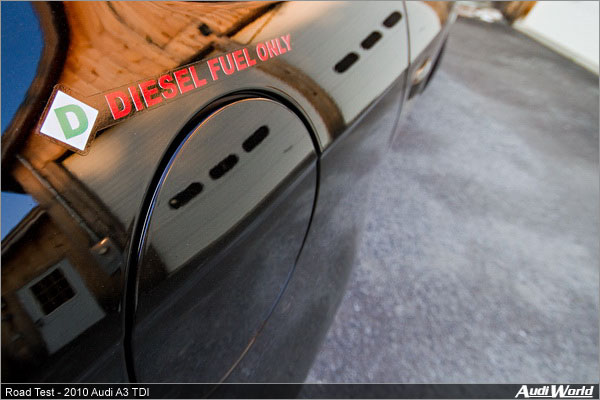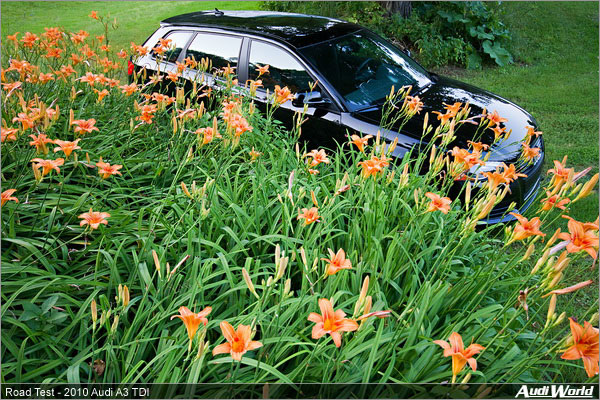Road Test: 2010 Audi A3 TDI

Diesel isn’t a dirty word anymore.
Most Americans seem to believe that diesel cars are no good, noisy, slow, smelly, soot covered jalopies. In most cases, this dislike of diesel is for good reason, based on the not so recent history of diesel powered cars in the USA. Other than a few decent VWs and Mercedes Benz diesels, the American automotive marketplace hasnt been flooded with diesel passenger cars. And the few attempts that American manufacturers have made with diesel cars were utter disasters. Ill be the first to admit that Ive driven a few really horrid examples of diesel cars through the years, such as a friend’s early 80s VW Rabbit diesel, and while visiting family in Germany, I had to endure my uncles diesel VW van, which was in all honesty, the slowest motorized vehicle Ive ever been in.
Keep in mind here, I like diesels. During the oil crisis in the early 70s, and my dad very cleverly purchased a Mercedes Benz 300D, so he could skip the long lines at the gas pumps, and purchase relatively plentiful diesel fuel at truck stops. Because of this I believe, I have diesel in my blood. I like the quiet clatter of a diesel engine at idle. I like the smell of diesel exhaust. Ive never owned a diesel car. But I want to.

In Germany, people have good reason for driving diesels. The fuel is taxed differently than gasoline; its half the price in some cases. It just makes sense to own a diesel car, even if its less fun (which it isnt, but more on that later). Here in the USA, with our relatively inexpensive gasoline, and love of big cars, the small diesels just didnt make as much sense. Big diesels are (were) too heavy, and loud, etc.
Not any more.
In this modern age of turbocharging, common rail ultra high pressure fuel systems with piezo injectors (just like their gasoline cousins), multi-valve cylinder heads, catalytic converters and zero maintenance exhaust particulate filters, and you find that diesel engines really arent anything like they used to be. Theyre quiet. They start instantly. They dont smell (at all). And best of all, they make piles of torque, with instant response to the accelerator pedal.
Enter the Audi A3 TDI. While its true that parent Volkswagen have been bringing diesels to America for a long while now, this is the first small Audi diesel since the 5000 back in the early 1980s. The A3 is a dramatically better car, in many ways. Weve always liked the A3; its a blast to drive, and its very useful. Its very pure in its handling, bringing us back to the days of lighter and smaller hot hatches. Combined with the eager and torquey TDI engine, the A3 becomes a perfect tool for commuting in style and efficiency.

The first thing you notice when you sit in the A3s comfortable (if slightly snug) seat and have a look around is, well it looks exactly like the gas version, except for the tachometer. Whats different you ask? Well, while the gasoline powered version will rev up to and over 6,000 rpm, the TDI version peaks out around 4,500 rpm. Twist the ignition key on, and youll see the usual warning lights blink on, and then off. One light catches your eye thats a little different – it’s the light for the glow plugs. Since diesels dont have spark plugs, they require heat in the combustion chamber to ignite the fuel/air mix. when the engine is cold, it would take forever cranking on the starter motor to generate sufficient heat from compression alone, so diesel engines have a plug that is electronically heated, to pre heat the combustion chamber.
In the old days of diesel, the glow plugs would operate for 5 to 10 seconds, depending on the outside temperature. With this A3 TDI, the light was on for at most 2 seconds, and the engine fired immediately. Granted, we didnt have the -15f weather that we often get in Vermont in the winter, but I dont think it would be any different based on what we saw. (Were not diesel n00bs, we run a diesel tractor all year, and it doesnt have any problems starting in extreme cold.)
Diesels tend to smoke a bit when they are cold, and even once warm, under heavy load. With a diesel there is no throttle to control the airflow into the engine. Enriching the fuel/air mixture speeds the engine up, and leaning the fuel/air mixture slows the engine down. If more fuel is added than can be burned, the result is the black soot that is commonly seen spouting from big trucks and tractors. With the modern TDI fuel injection and turbocharging, combined with the catalytic converter and particulate filter, you will have absolutely zero soot or smoke from the tailpipe, ever, because the air/fuel mixture is always kept in check. In the week we had the A3 TDI, we saw no soot buildup on the chrome tailpipe. Cant say the same for any other gas powered car weve driven.
Then theres the smell. Thats probably one of the biggest complaint we heard from people regarding diesels. Personally, I find the smell of a poorly running gas engine more offensive than the smell of a diesel engine, but to each his/her own. In any event, there is absolutely no smell to the exhaust at all. If anything, it smells like the exhaust from a propane appliance, which is to say, basically odorless. Occasionally we smelled something that reminded us of a bleach type scent, after a particularly hard romp. But that was it. Obviously diesel fuel itself is pretty nasty stuff, really stinky. Theres no way around that, and its not like gasoline smells like roses either, but we would suggest keeping a box of disposable gloves in the trunk for refueling, or find a full service station.
Having mentioned refueling, our A3 TDI loan was the first loaner that we did not have to refuel even once, and not for lack of driving it. We put somewhere in the area of 430 miles of heavily mixed driving on the car, on one tank of ultra low sulfur diesel fuel. Yes, we tend to drive like journalists, which is another way of saying that we like to explore what the car can do. And lets be honest here, with only 140 hp on tap (but with 236 lb/ft from just above idle peaking out at 2500 rpm) its not a rocket sled, nor is it intended to be. But, if you drive it correctly, its not slow either. Acceleration from 0 to 60 is about 8 seconds, which may seem on the leisurely side, but once underway the car is genuinely quick, with plenty of power for hills and passing. The key is to keep the revs at or around 2000, and to not be hesitant to put the accelerator to the floor for maximum power. Obviously, this does impact fuel economy, but not as badly as you might be thinking. This is a diesel after all, and diesels like being run hard.

Because the A3 TDI is front drive, and relatively small, and in the case of our car with its sport package suspension, its an absolute blast to drive. The A3 craves being thrown into corners. Handling truly is go-cart like, drama free, with no body roll, and with no unsavory behaviors. Because of the fact that the A3 carves turns with extreme ease, there is less need to slow down, and therefore less need for crazy power to accelerate out of turns.
The TDI is only available with the 6 speed dual clutch S-Tronic gearbox. We have no problem with this, its a great transmission and it obeys manual overrides exceedingly well. One thing that seemed strange to us though, was that the gear ratio spacing felt somewhat odd (too close) and not becoming of a diesel. Diesels traditionally have very long gear ratios and final drive which lets the engine stay in its torque peak longer. In manual mode, it took a fair bit of reprogramming of our shifting habits to keep up with the 3500 rpm optimum shift point, most often it was difficult to shift fast enough through the lower gears. We found it much better off the line to use D, or S, and let the transmissions computer do the work. This resulted in smooth acceleration which also kept the engine in its sweet spot not only for power, but for economy.
In this day and age of frugal gasoline cars, hybrids, and so on, all of the talk associated with those vehicles is always economy, and thats it. No one ever talks about how fun their hybrid is to drive. Not so with the A3 TDI. The best thing about this car is, its a really fun car to drive, and it just happens to get remarkably good fuel mileage. Its a cool little hatchback, its useful for carrying things and people. And its Green. It was voted Green Car of the Year by Green Car Journal last year, which is a huge honor indeed! And none of that reduces its cool factor in any way, if anything, it makes the A3 TDI cooler to own.
Part of the fun of having a car thats a little different than other peoples cars, is having other people notice that your car is different. In this regard, the A3 TDI is a bit disappointing. The only thing that might give the TDI away is very slight diesel engine sound at idle. Once underway, it sounds like a regular 4 cylinder, albeit one with a huskier baritone voice. Honestly, its a little disappointing that the car is so quiet, because it sounds really cool under load. Much like Audis diesel powered Le Mans winning R15+, the engine is so quiet, that you dont hear much of it.
And through it all, it remained a really cool car, which was truly fun to drive. Next time we vow to try to see how many miles we can get out of it, using various techniques for fuel economy. That should be fun!





